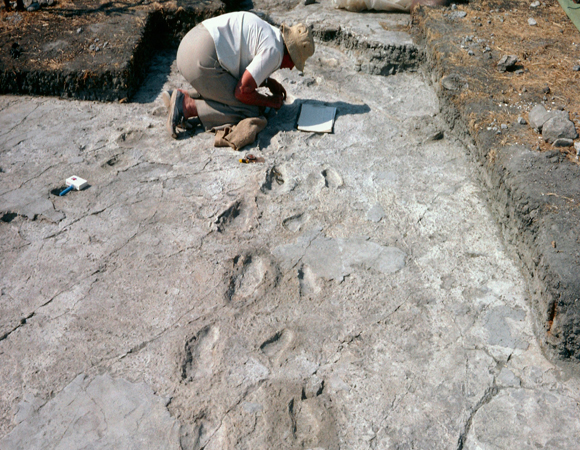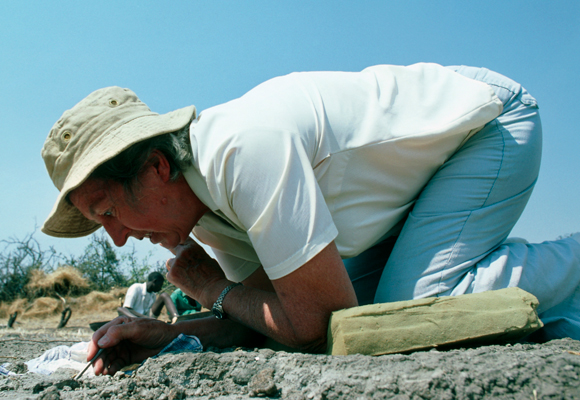Mary Leakey, a self-taught paleoanthropologist with no formal education, led multiple excavations in Africa and her findings were pivotal in shaping our understanding of how our prehistoric ancestors evolved
By 1976, at age 63, Mary Leakey had already earned a reputation as an anthropologist and an expert on the origin of man. Along with her husband, Louis Leakey, she studied fossils in Africa for over 40 years. The couple were responsible for many discoveries, from ancient tool stones to a new early hominid species, Paranthropus boisei. However, this discovery, made a few years after Louis’s death, was different. This time it wasn’t bones or tools, but footprints, left in wet volcanic ash in the plains of Tanzania, about 3.66 million years ago.
We will never know exactly what happened that ancient day. There were apparently three of them, walking in the same direction, on feet that looked almost like our own. One of them lagged behind, since his footprints are sometimes superimposed on those of the two walking in the front. Judging by the depth and the stride length of the footprints, the three were of short stature, and one of them was slightly larger than the others.
From here on out, all that remains are merely speculations. The footprints of the smaller one contained signs that he could have been carrying a heavy load on one side – could it have been a mother carrying a baby on her thigh? Maybe the three were a family that went out to wander at the foot of the volcano? We will never know the details, but one thing that the footsteps clearly attest to is that even at this early time, upright walking hominins (species of human ancestry) roamed East Africa. Thus, Leakey’s last great discovery helped settle an old debate among scholars – whether upright walking preceded the evolution of larger brains, or vice versa.

Tracks that shed new light on the evolution of ancient humans. Leakey studying the famous footprints | Photo: Science Photo Library
Hard work
Mary Leakey was born Mary Douglas Nicol, on February 6th 1913 in London. She developed an interest in archaeology from an early age and began joining archaeological excavations across Britain at the age of 17. She attended lectures in the fields of archaeology, geology and prehistory that were open to the public, but did not have the patience for formal education and never attended university or studied for an academic degree. Many years later Leakey was awarded honorary doctoral degrees by distinguished universities, including Yale and Oxford universities. “Well, I have worked for them by digging in the sun”, she said in an interview for Scientific American.
At a meeting held after one of the archaeology lectures she attended, she met Louis Leakey, who was already a renowned paleontologist at the time. In 1934 he asked Mary, who was known for her artistic skills, to illustrate his book Adam’s Ancestors, and it wasn’t long before the two fell in love, in spite of the fact that Louis was married at the time and recently became a father. It wasn’t until 1936 that his divorce came through and the two were married.
The couple arrived in Tanzania even before that, in 1935, which was Mary's first time in Africa. The continent soon became her home, where she had spent all her life, leaving only rarely for visits to Europe and the U.S.
Everyone who worked with her immediately realized that Mary was much more than Mrs. Louis Leakey. She not only joined her husband’s excavations, but she conducted them. Louis was a man of theories, responsible for finding the most promising locations for excavation, for forming hypotheses about the discovered findings, and for everything that had to do with publicity and communication. Mary was the one who focused on the excavations themselves, introducing accurate methods of excavation and setting new standards for meticulous documentation into a field that lacked these prior to her work.
“The thing about my mother is that she is very low profile and very hard working”, said Richard E. Leakey, Louis and Mary’s son and a distinguished paleontologist in his own right, to Scientific American. “Her commitment to detail and perfection made my father's career. He would not have been famous without her. She was much more organized and structured and much more of a technician. He was much more excitable, a magician.”
It was no coincidence that she was the one to find the skull of Paranthropus boisei, perhaps their greatest joint discovery. And it was definitely not a coincidence that she was almost entirely absent from the ensuing debate, regarding the exact location of the new species on the human lineage. “I never felt interpretation was my job”, she said. “What I came to do was to dig things up and take them out as well as I could”.

Kept a low profile and worked hard. Mary Leakey at the excavation site at Laetoli, Tanzania | Photo: Science Photo Library
Early Standing
Leakey continued to study fossils even after Louis’s death in 1972. Among other things, she returned to the site of Laetoli in Tanzania, were she had previously dug with her husband. Legend has it that it was elephant dung, along with the somewhat childish character of two of the young researchers, that led to the breakthrough: one of them was tossing a part of the fragrant pile onto his friend, who, while trying to dodge it, stumbled upon what turned out to be the ancient footprints of a large mammal.
That was how the first animal footprints were discovered - they were tracks made by giraffes, birds, and many elephant tracks. Leakey and her team had excavated and uncovered all of these footprints and kept looking for more. It took them two years to find the holy grail: tracks of hominins, walking upright on two legs.
The hypothesis that the large brain in human evolution preceded and was responsible for the development of bipedalism (upright walking) and all the subsequent changes, was highly acceptable during the 20th century. However, in 1976, when the Laetoli footprints were discovered, it had already begun to fall apart. Leakey’s discovery was the final blow.
It is not difficult to see why this hypothesis was initially attractive to many scientists. Our large brain, and especially, the cognitive abilities that come along with it, are usually considered the central and most important human trait. Our way of walking, however, seemed almost incidental, and definitely less significant – after all, kangaroos and ostriches also walk on their hind legs. Perhaps the strongest evidence for this concept is the name given to our species: Homo sapiens, meaning “wise man” or “knowledgeable man”. After all, no one considered the name “the bipedal man” to define our species. The fossil findings that existed at the time also seemed to support the same hypothesis – they all belonged to Neanderthals, and their brains were indeed very large.
The theory encountered it’s first obstacle in 1924, with the discovery of the “Taung Child”, a three million year old fossil from South Africa. Its small skull couldn’t have contained a brain much larger than that of a chimpanzee, but the location of its connection to the spine suggested an upright posture. Other fossils discovered since then have reinforced the claim that our ancestors walked upright before their brains had increased considerably. The best example of that is “Lucy”, discovered in 1974. The 3.2-million-year-old fossil contained not only the skull but also parts of the pelvic and leg bones, and researchers have determined with fairly high certainty that despite her small brain, Lucy was bipedal.
The footprints at Laetoli were probably made by Lucy’s species, Australopithecus afarensis, but they were made nearly half a million years earlier, and did not merely suggest an upright posture but demonstrated how it worked.
The footprints clearly showed that the big toes of the Australopithecines were forward facing, aligned with the other toes, as opposed to the feet of apes, where the big toe turns sideways allowing a good grip of tree branches. The footprints also show that the heel was the first part of the foot to strike the ground, followed by the toes, similar to the manner we walk today. There is no doubt that they belonged to a species that, at least partially, had moved down from the branches, to living on the ground.
As early as 1871, in his book The Descent of Man, Charles Darwin commented that hands and arms could hardly have developed into the role they perform today, as long as they were continuously used for locomotion. It remains unclear what motivated these ancient people to stand upright and become bipedal, but many researchers believe that once they freed up their hands to create, manufacture, carry and use tools, they were on track of the technological advancement that culminated in our species. Naturally, in order to create more advanced technology, these early humans also needed to develop their cognitive abilities. Thus, it is possible that our large brain not only appeared after bipedalism, but was in fact a direct result of it: in a species that was becoming more and more technologically advanced, there was a significant advantage for having a larger brain.
Leakey, as usual, did not feel compelled to intervene in the debate over the meaning of the footprints. She continued excavating in Laetoli as well as in the nearby Olduvai Gorge, where she had worked for years with Louis, writing and publishing articles and books. She died in 1996, in her home in Nairobi, Kenya, at the age of 83.
The researcher who raised three children while carrying out her work at the excavations, who came to Africa as “Leakey’s wife” and built a name for herself at a time where there were hardly any female researchers in the field, considered this aspect of her life not at all interesting and did not understand why interviewers kept asking her about it. “'What was it like to be a woman? A mother? A wife?”, she quoted the questions she would hear time and time again, summing it up: “I mean that is all such nonsense”.
An hhmi video about Mary Leakey and her work:
